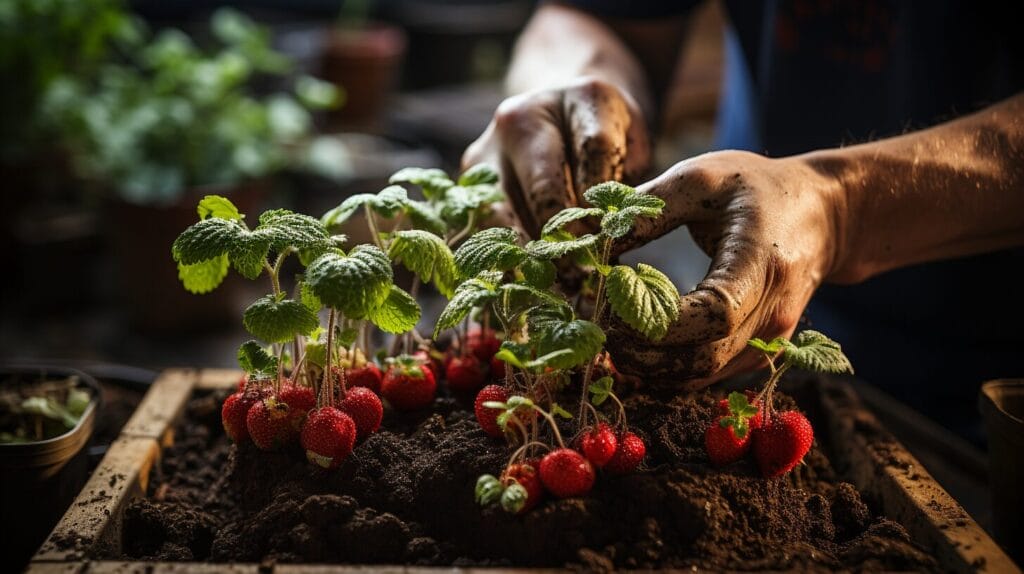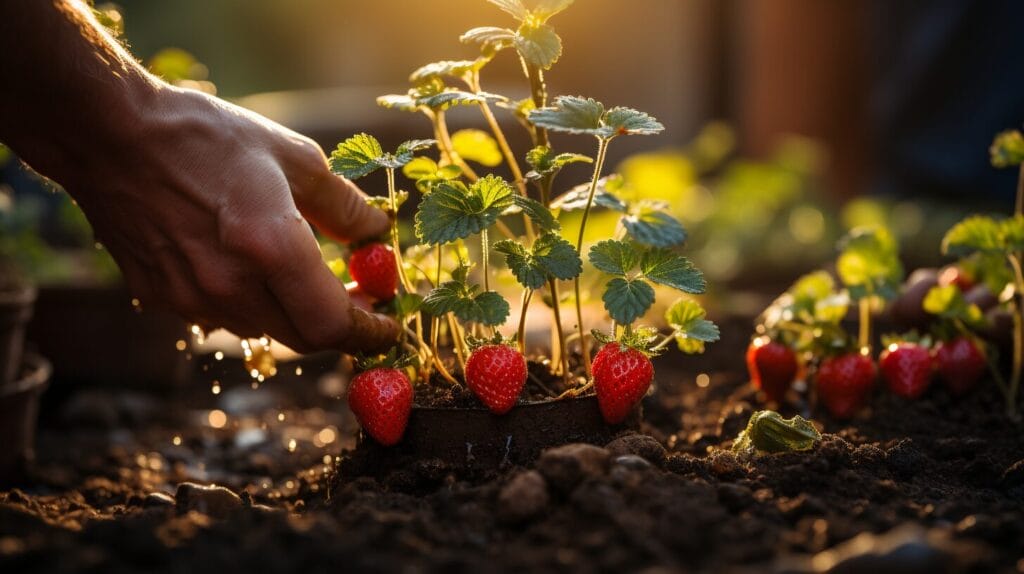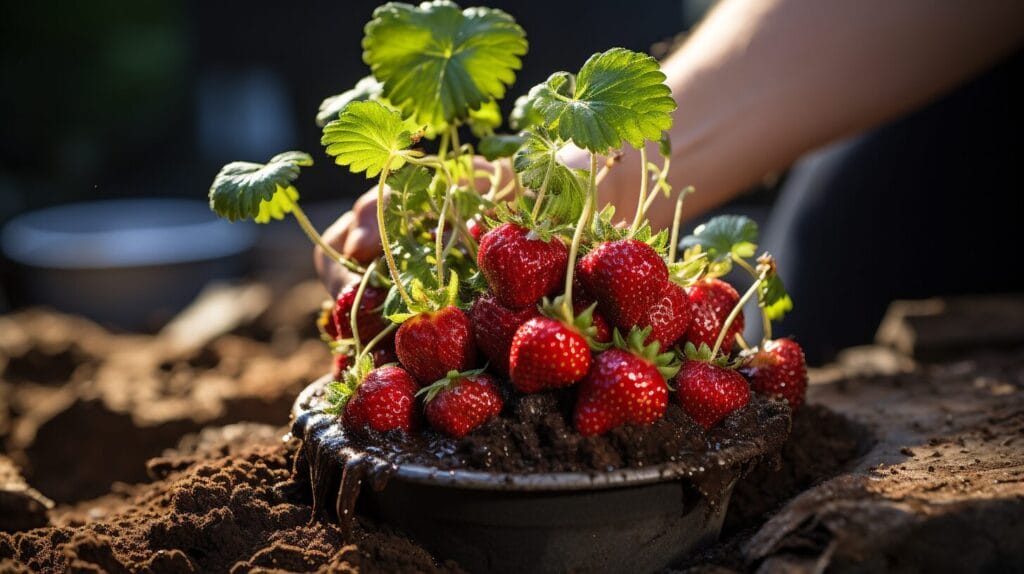As winter’s cold embrace starts to yield to the gentle arrival of spring, you find yourself poised for a rewarding voyage – nurturing bare-root strawberries to fruition. Immersed in the charm of cultivating your own berries, you comprehend that success is intricately linked with strategic timing and skilled knowledge.
Planting bare-root strawberries requires more than just good intentions; it demands precise preparation, from selecting the right spot in your garden to ensuring the soil is a welcoming bed for these tender starts.
The perfect strawberry patch is within your reach, and with a little guidance, you’ll soon be on the path to enjoying the fruits of your labor. Stay with me, and I’ll show you when to plant bare root strawberries and how to nurture them.
Key Takeaways
- Soaking the roots in water before planting ensures hydration.
- Choosing a site with good drainage and no weeds or grass reduces competition and promotes growth.
- Consistent watering is crucial for survival and growth.
- Harvest strawberries when they are fully ripe, bright red, and easily detach from the stem.
Understanding Bare Root Strawberries: A Guide for Gardeners

Understanding bare-root strawberries begins with recognizing them as a cost-effective option for gardeners looking to establish a fruitful berry patch. These plants arrive without soil, offering a head start to a healthy plant at a fraction of the cost of potted counterparts.
When you plant bare-root strawberries, you’re investing in the foundation of a robust root system that will support the plant throughout its life.
To maximize the yield that your plants produce, follow these key steps when planting bare-root strawberries. Soak the roots in water for a few hours before planting to hydrate them and prepare them for their new home in your garden.
Choose a site that has good drainage and is free from weeds and grass to reduce competition for nutrients and water, allowing your strawberries to thrive. Mulching around your strawberries after planting is beneficial to keep the fruit clean, minimize weed invasion, and maintain soil moisture.
Preparation Stages for Planting Bare Root Strawberries

Your journey to a luscious strawberry patch begins with careful preparation:
- Select a sunny planting site with well-draining soil to grow strawberries successfully.
- Clear the area of weeds and grass, ensuring your bare-root strawberry plants won’t have to compete for nutrients and water.
- Hydrate your strawberry plants before planting by soaking the bare roots in water for an hour.
- Cover the roots entirely but ensure the crown of the plant is right at the soil surface.
- Water the strawberries thoroughly to settle the soil around the roots and eliminate air pockets.
Here’s a concise guide to help you:
| Step | Description | Importance |
|---|---|---|
| Prepare the Planting Site | Clear weeds/grass, enrich the soil with compost | Ensures healthy growth |
| Hydrate the Roots | Soak bare root plants in water for 1 hour before planting in your strawberry bed. | Revives dormant plants |
| Plant and Water | Cover roots, keep the crown at the soil surface, water | Establishes the plant |
Step-by-Step Guide to Planting Bare Root Strawberries

- Carefully unpack your strawberries, keeping their roots moist.
- Choose a sunny, well-drained spot in your garden.
- Prepare the planting hole to be wide and deep enough to accommodate the roots without bending them.
- Fan out the roots gently over the hole in your strawberry bed to encourage the outward growth of your new plant.
- Place the plant in the hole, ensuring the crown sits just above the soil level.
- Backfill the soil around the roots and firm it down to eliminate air pockets.
- Water them thoroughly to settle the soil and provide necessary hydration, reducing transplant shock.
Caring for Your Newly Planted Strawberries

Consistent watering is essential for the survival and growth of your newly planted strawberries, especially in the first few weeks as they establish their root systems. Keep the soil moist but not soggy to prevent root rot.
Enrich your strawberry plants with organic materials like straw or pine needles to retain moisture, suppress weeds, and protect the plants from temperature extremes.
Remove runners during the first year to allow the main plant to establish itself and produce fruit.
Moving Forward: From Bare Root to Bountiful Harvest

Transitioning from planting bare-root strawberries to nurturing them into a bountiful harvest requires patience and know-how.
- Water Wisely: Regular watering is necessary, but avoid waterlogging the roots.
- Feed Your Plants: Use balanced fertilizer to support healthy growth and fruit production.
- Protect Against Pests: Netting may be necessary to keep birds and other animals at bay.
Monitor your bare root plants for signs of disease or distress, and harvest when the strawberries are fully ripe, usually in late spring to early summer.
Can I Plant Bare Root Strawberries and Burpless Cucumbers in the Same Patch?
Yes, you can plant bare root strawberries and burpless cucumbers delight in the same patch. Just make sure to give each plant enough space for their roots to grow and ensure they receive adequate sunlight and water. It’s a great way to maximize your garden space and enjoy a variety of produce.
Is there a specific planting season for bare root strawberries?
Yes, there is a specific planting season for bare root strawberries. It’s best to plant them in early spring or late summer, depending on your climate. By understanding potato plant yields, you can also optimize the planting time for strawberries to ensure a successful harvest.
Conclusion
You’ve set the stage for a strawberry haven in your garden. Keep those roots moist, and the bed weed-free, and nurture your plants. Before you know it, you’ll be enjoying sun-kissed, flavorful strawberries. Stick with it, and your bare root beginnings will lead to a lush, bountiful harvest.
Here’s to the sweet success awaiting in your very own berry patch!
Frequently Asked Questions
What type of strawberry is best to grow in a home garden?
The best type of strawberry to grow in your home garden depends on your preference and your climate. The most common strawberry varieties include June-bearing strawberries, everbearing strawberries, and day-neutral strawberries. June-bearing strawberries are produced once a year, everbearing strawberries are produced in the spring and fall, while day-neutral types can produce in all growing seasons.
What is the best time to plant bare-root strawberries?
The best time to plant your strawberries depends on the variety chosen. For June-bearing strawberries, it’s best to plant in early spring so they have time to establish themselves before the growing season. Everbearing strawberries need to be planted as early as you can work the soil in the spring.
How should I prepare my bare-root strawberry plants before planting?
Before you plant your bare-root strawberries, you should soak the roots in lukewarm water for an hour. After soaking, you should fan out the roots to ensure that they cover as much area as possible. Long roots can be trimmed slightly.
How should I store the bare-root strawberry plants before planting?
If you cannot plant your bare-root strawberry plants immediately upon receiving them, it’s essential to keep them in a cooler, dark location and ensure the roots remain moist. Do not let the roots dry out or freeze.
When to plant bare root strawberries and when will it produce?
The mother plant typically starts developing berries about 4-6 weeks after planting. June-bearing strawberries usually produce berries in their second season. Everbearing and day-neutral strawberries may produce berries in their first season if they are planted early enough.







